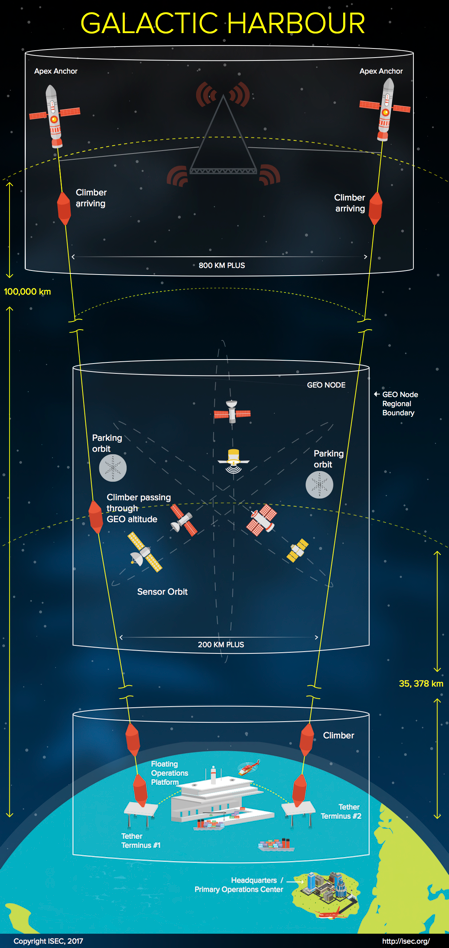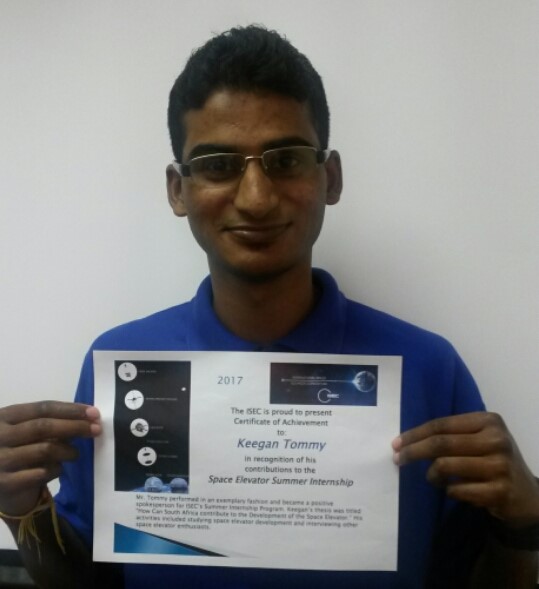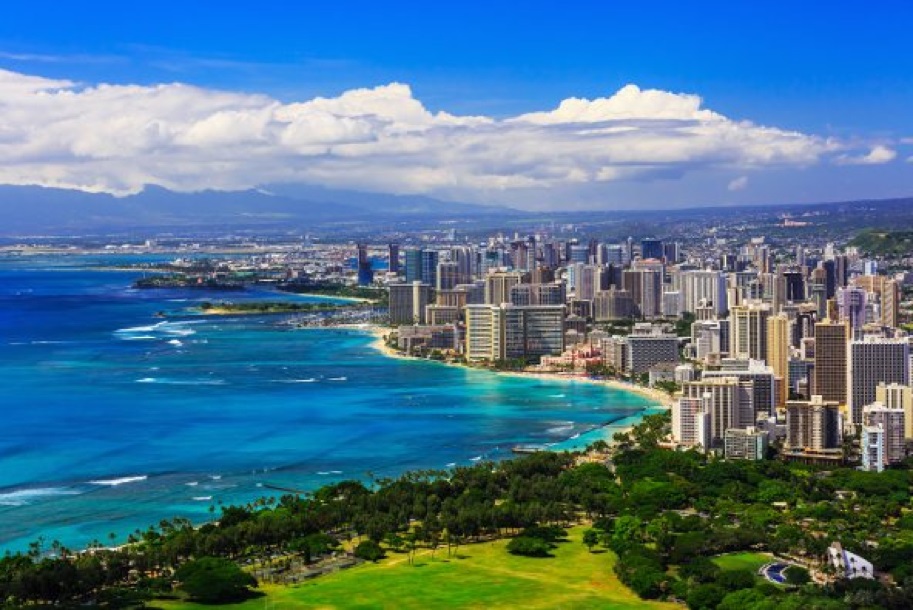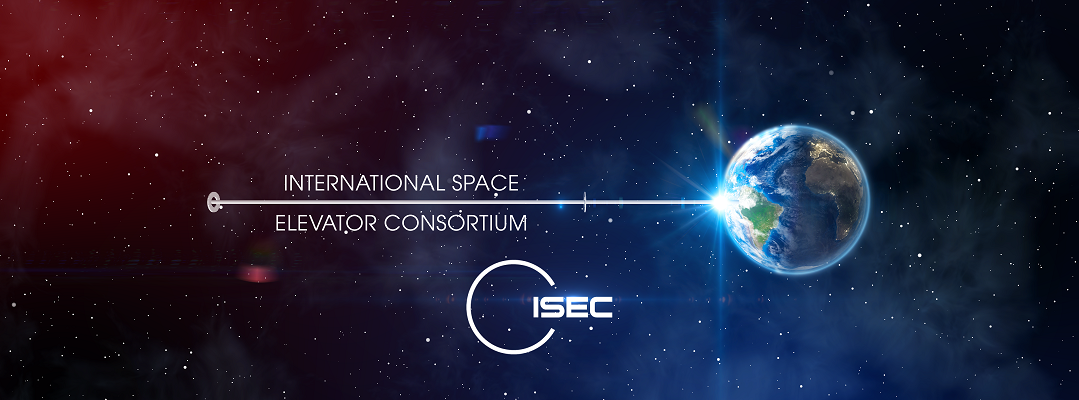|
| |
Welcome to the December 2017 Edition of the ISEC Newsletter

Dear Friend,
In this edition, you will find an update from our harbormaster on a preferred location for the Space Elevator's Earth Port. Read on for a summary of the British Interplanetary Society Symposium held last month. We also have another write-up from one of our
summer Interns. There are also some exciting upcoming Space Elevator related
events around the world that you will want to check out. Thank you for reading and lending your support
in the development of Space Elevators!
As always, you will find notices of
several open volunteer positions (a great way to help this project, even if
you’re not a scientist or engineer) and a reminder that all ISEC
reports, Yearly Reports, CLIMB Journals and the Via Ad Astra Magazine, are now
available FOR FREE in electronic (pdf) format at ISEC.org. There is
plenty of work to be done!
If you want to help us make a space
elevator happen, JOIN
ISEC and get
involved! A space elevator would truly revolutionize life on earth and open up
the solar system and beyond to all of us.
Please don’t
forget to LIKE US on Facebook, FOLLOW US on Twitter, and
enjoy the photos and videos that we’ve posted on Flickr and YouTube – all under our Social Identity of ISECdotORG.
Thank you,
Mark Dodrill
ISEC Webmaster
President's Corner

Membership is Important!
Please join ISEC, as we are in the process of moving the
space elevator concept forward and would love your help. We have a small group of committed
enthusiasts who are keeping the dream of space elevators active and alive. We understand the tremendous issues that are
facing us, not least of which is the ability to produce a material strong
enough and long enough to provide a safe structure to race upon to the
stars. However, we would like to start
the process building a large space infrastructure enabling low cost, routine,
and safe lift to space. We have a
three-step plan:
Step One: Research kicking off the development
Step Two: Deployment and build-up of space
elevators
Step Three: Operations enabling robust commercial and
government access to space while enabling humanity’s movement off planet
Along with this three step plan we have activities that are
essential to success in the long run. We
must keep ISEC alive and well with the mission of ensuring space elevators are
included inside the arena of “New Space.”
We have a real challenge as people are taking off in all kinds of
directions with over 20,000 satellites being proposed for commercial
constellations while Musk and Bezos are thinking bigger with delivery of
product and people to the Moon and Mars.
The space elevator can enable this movement into a robust commercial
space world, but we need support at the basic level.
The first level of support is membership. Please go to www.isec.org and punch the button “join” with the intention to not only submit dues, but
also support in other ways such as review the monthly newsletter, review the
study reports already completed, and then talk about space elevators with your
friends and within the schools in your area.
Information sharing is one area each of us can contribute. I was just at Arizona State University and
the students are all about the future of space travel and where our industry is
taking them.
Please join ISEC and enjoy the rewards of helping move
towards the future.
Keep Climbing my Friends!
Pete Swan
President, ISEC
Why the Transition the focus to Galactic Harbour?


The development of a future space elevator infrastructure
requires us to open our minds and assess the businesses that will accompany
development. The infrastructure will be
refined as we move forward only if we can ensure that the whole project will
lead to profitability and that it will encourage enterprises to flourish inside
the various regions. During 2016, the
ISEC identified the concept of Galactic Harbour. During this year, we have refined the
concepts associated with a Galactic Harbour and have incorporated it into the
ISEC strategy for the future. ISEC
introduced a developmental strategy as a unifying vision:
Our “strategy” is to link the
Space Elevator Transportation System to the Space Elevator Enterprise System;
within a Unifying Vision - the Galactic Harbour. It is best to read such
things very slowly and to interpret them for insight and clarity. The
strategy cites a transportation system AND an enterprise. It also calls
for unification (a unifying vision). The core idea is that we are to
build two things and then unify them. Another version of this thought is
that we build one that enables the other; or we are to build the first so that
we may also have the second.
It is important to keep the elements and activities of a
harbor in mind: main channel, entry, departure, port services, security, and so
on. The definition would become:
“The Galactic Harbour operates in
a continuous manner, moving customer payloads and support material within Climbers;
moving along Tethers. The Climbers rise
from the Earth Port toward exit gates at the GEO Region, or the Apex Region
above. The delivered payloads are the future’s new versions of today’s
operating satellites; and the support material is seen as “spare parts” for
payload repair, refueling, and more. It would most logically be the Earth
Port where the customers have their payloads loaded on Climbers and then the
release points are at altitudes as per the desires of the customer.”
Click to continue reading: https://isec.org/why-transition-the-focus-to-galactic-harbour/
Keegan Tommy Completes 2017 International Space Elevator Consortium’s Summer Internship

Mr. Tommy is a 3rd year Chemical Engineering Student at the
University of Johannesburg, South Africa. During this summer he interviewed a
senior person in South African space activities and conducted a survey at his
university. He was also required to accomplish research and provide a short
thesis on a designated topic. He chose a
topic related to his country and their interest in space activities.
His title and Executive Summary follow: “How Can South Africa contribute to the
Development of the Space Elevator?”
On the 6th of June 2017 I was tasked by the International
Space Elevator Consortium to create a thesis as to how South Africa can
contribute to the development of a Space Elevator? In order to complete this task I arranged for a one-on-one
interview with the Chief Engineer of the South African Nation Space Agency
(SANSA) and also conducted a group discussion with top professors and lecturers
of the University of Johannesburg and the Witwatersrand University. In
addition, electronic communications were conducted with external companies that
aim to develop their own rocketry program or are trying to introduce rocketry
skills for young students. Finally, a survey was distributed and compiled for
University Students in the University of Johannesburg.
I have come to the conclusion that South Africa, as a
country, is not able to contribute to the development of the Space Elevator due
to its lack of a stable economy and government; however, the people of South
Africa possess the skills, knowledge and creative thinking to contribute to the
development of a Space Elevator.
China announces it would like a Space Elevator by 2045

(Yicai Global) Nov. 17 -- The China Academy of
Launch Vehicle Technology, a subordinate of the nation’s main space program
contractor China Aerospace Science and Technology Corp. (CASC), recently laid
out long-term plans for its space program, under which it hopes to develop
reusable sub-orbital spacecraft by 2025 to allow for space tourism and build a
space elevator by 2045, state-owned news agency Xinhua reported yesterday.
https://www.yicaiglobal.com/news/china-shoots-stars-plans-build-space-elevator-2045

EARTH PORT Update #9 November 2017

In ISEC Position Paper #2012-1, the
“preferred” location for the Marine Node, now Earth Port, was approximately
1,000 km west of the Galapagos Islands on the Equator in the Pacific Ocean. The
location for the Headquarters/ Primary Operating Center (“HQ/POC”) was to be in
San Diego, California, USA. Subsequent ISEC and International Academy of
Astronautics (“IAA”) studies and publications have carried these locations
forward. The primary criteria for the Galapagos site was that it is within 3
degrees of the Equator in the open ocean with benign weather conditions
including a low incidence of lightning strikes, calm seas and minimum cloudy
days. F
For some time, since I became involved
in ISEC studies (Earth Port, GEO Node, Apex Anchor, Earth Port updates), I felt
that there are additional factors to be considered in “fixing” these key
locations. Based on my experience in the transportation industry as a seaport
facilities developer, I believe that the methodology, security, and time from
payload origin to Access City to Earth Port to Tether Terminus should be
considered. Another key factor, discussed during a 2016 ISEC Conference
mini-workshop on Earth Port location criteria, was the availability of space in
geosynchronous orbit for the GEO Node. Further, as a strategy emerges for
linking the Elevator Transportation System with the Space Elevator Enterprise,
the Galactic
Harbour, the business climate of the city in which the HQ/POC is
located must also be a determining factor.
As a result of these considerations,
and others, I prepared and presented to the attendees of the 2017 ISEC
Conference in Seattle this month a paper entitled: “Earth Port Access City, The Case for
Honolulu, HI” In this paper, I developed a rationale for eliminating
the Galapagos site and the City of San Diego as “preferred” locations for
future Space Elevator facilities. In their stead, I identified a region of
equatorial Pacific Ocean near Kiritimati (“Christmas”) Island as the best
location for the initial Earth Port. This site would be served a HQ/POC located
in or near Honolulu, Hawaii as the Earth Port Access City. The specific
recommendations to the ISEC Board of Directors and the ISEC community that I made
are as follows:
-
The Earth Port Access City should be shown as a key element
of the Space Elevator System,
-
The HQ/POC should be located in or near the Earth Port
Access City,
-
The new preferred Earth Port location should be located in
the Mid-Pacific Ocean at approximately 0⁰ N, 154⁰ 05’W south of…
-
Honolulu, Hawaii, on the island of Oahu, the Earth Port
Access City
Vern Hall, Earth Port Harbor Master
BIS Space Elevator Symposium : 7th November 2017

This 1-day Space Elevator (SE) Symposium was held at the
headquarters of the British Interplanetary Society (BIS) at 'Arthur C Clarke
House' in London, jointly sponsored by BIS and ISEC.
Nine fascinating presentations were made during the course of the
day, with all well received by a small but keenly interested audience: in
particular the Skype presentations by key ISEC representatives ran smoothly,
enabling explanation of key concepts by three greatly experienced SE
proponents.
Talks ranged from SE history to technical details of SE concepts,
including new work on SE options throughout the solar system. Of particular
interest was the news from Adrian Nixon of a breakthrough in graphene
production techniques, offering the tempting prospect of a feasible strong
material for an Earth Elevator system.
In more detail:
1. John Knapman introduced the concept of the Space Elevator,
describing the rationale, history, current architecture concepts, physics and
challenges. He introduced ISEC, and concluded with 'Final Thoughts' from
various thinkers.
2. Martin Lades (on a day trip from Germany) presented detailed
analysis on critical feasibility criteria, with emphasis on climber power,
payload and tether interface issues. Tether friction was shown to be as
critical as strength, and a significant proportion of early climber payloads
could have to be allocated to tether construction and maintenance. He followed
this with a second talk on Mars Elevators, specifically the 'Omaha Trail'
concept. Unfortunately, there was insufficient time to complete this second
presentation.
3. Mark Haase presented (via Skype) on 'Advances in High
Strength Materials', describing multiple materials using an Ashby Plot before
focusing on descriptions of Carbon Nanotubes (CNT), Graphene and Boron Nitride
materials. He concluded that the required 25 MYuri would be achieved in 'about
20 years', and would be a CNT-polymer composite. Much further research on
cross-linking and polymer interfacing is required.
4. Peter Robinson described a simple analysis technique
that has enabled rapid review of SE feasibility on multiple locations in the
Solar System. Of the eight major planets, only the Earth and Mars would be
feasible, but both require new materials. L1-type elevators could be built on
many moons using current materials: an SE on the Earth's Moon would be at least
80,000km long, so not ideal for technology demonstration. The least challenging
location would be on a large asteroid: Vesta was selected as optimum, with a
tether 750km long.
5. Adrian Nixon outlined his experience and current activity
specializing in graphene, and went on to describe the specific material
requirements for a strong SE tether material. He explained how current graphene
manufacture yielded individual nanoplatelets with little overall strength, and
described new techniques for making far stronger continuous graphene sheets
using Chemical Vapor Deposition (CVD). He concluded that development of CVD
production techniques would yield graphene material of the strength required
for the (Earth) SE, describing in-orbit combination and how graphene addresses
some anticipated SE operational issues.
6. ISEC President Pete Swan presented (via Skype) on the
'Galactic Harbour: Half Way to Anywhere'. He described current Space Elevator
concepts, history and lexicon, followed by a description of past and current
IAA and ISEC studies. He described the potential future activities at and
around the Earth Port, GEO Node and Apex Anchor locations, and concluded with
his Unifying Vision of Space Elevators as a Galactic Harbour.
7. Ian Woolard presented his concept for Safe Space Fountains
for low cost orbital launch. He outlined a dynamic structure that could be
built using existing materials, arguing that a smaller system (80km high) could
avoid the safety and cost concerns surrounding other Launch Loop proposals. He
explained that dynamic analysis had addressed stability concerns, and estimated
that a launch cost of GBP 160/kg to LEO could be achieved. Funding is required
to enable small-scale demonstration.
8. David Raitt presented (via Skype) on a 'Short History of
Space Elevators'. He described the detailed rationale, history and pioneers of
the SE concept, followed by examples of literature and artwork. He then covered
the scientific work from the 1990s onwards, detailing various conferences,
sessions and competitions. He described press and on-line publications over the
last 20 years, and concluded by confirming that 'Tomorrow Never Comes … The
future is the History of Tomorrow' !
9. John Knapman closed the Symposium by describing the current
state of Space Elevator research. He described material research status,
climber design & power concepts, hazards & maintenance, and the 'High
Stage One' and 'Multi-Stage' Elevator concepts. He then outlined the current
ISEC project on building a simulation package to model dynamics, electrodynamics
and radiation behavior. He concluded by outlining the recent JBIS publication
and described the research work in progress by ISEC, in Japan and in China.
Thanks must be given to BIS for their friendly and faultless
hosting of the event at their small and intimate venue, with seamless technical
support ... and of course excellent catering!
This summary presents only an outline of the presentations, and
may omit or misrepresent some of the work. PDF copies of all papers (except #7)
will be available from BIS or ISEC in due course.
Peter Robinson November 2017
Upcoming
Space Elevator Related Events:

National Space Society
International Space Development Conference
Los Angeles, CA, USA May 24-27 2018
Space Elevator Track
Web Site for more information: http://isdc.nss.org/2018/
International Space Elevator Consortium
Space Elevator Conference 2018
Seattle Museum of Flight (Tentative)
Late August 2018 - Final date is TBD
Season of Giving

President’s Request
Please think about donating to a charitable organization, ISEC,
during this season of giving.
Our acceleration towards a real space elevator this year has been
exciting. As we have taken on more responsibilities, we have more
opportunities. Your support goes towards programs such as ISEC Summer
Internships. Thank you from the ISEC leadership team, especially your
president.
Note: Donation tab at www.isec.org – upper right – makes it easy.
Pete
|
| |
|
|
|
Email Marketing By
|


|
|
|
|
